Sins of the Flesh
Ten of the best body horror movies
Warning: This article is moist
When it comes to horror, some of us favour the slow-burn psychological chillers, such as Misery (1990) or the iconic The Silence of the Lambs (1991). The thinking goes that what our imagination conjures will always be more terrifying than whatever grotesque vision a director might project on screen.
Then come the filmmakers who say, “Hold my corn syrup,” and proceed to prove just how spectacularly wrong we were to doubt them.
Body horror is a genre apart. It’s not about what lurks in the dark—it’s about what festers inside us. It plays on the fear of decay, the violation of the flesh, and the betrayal of our biology. It’s squishy. It’s sticky. It’s sick.
From a man’s grotesque transformation into a 6’4” housefly to the most biting commentary on society’s obsession with female beauty ever put to film, these are ten of the best body horror movies ever made.
Be warned: from this point on, here be spoilers.
The Thing (1982)
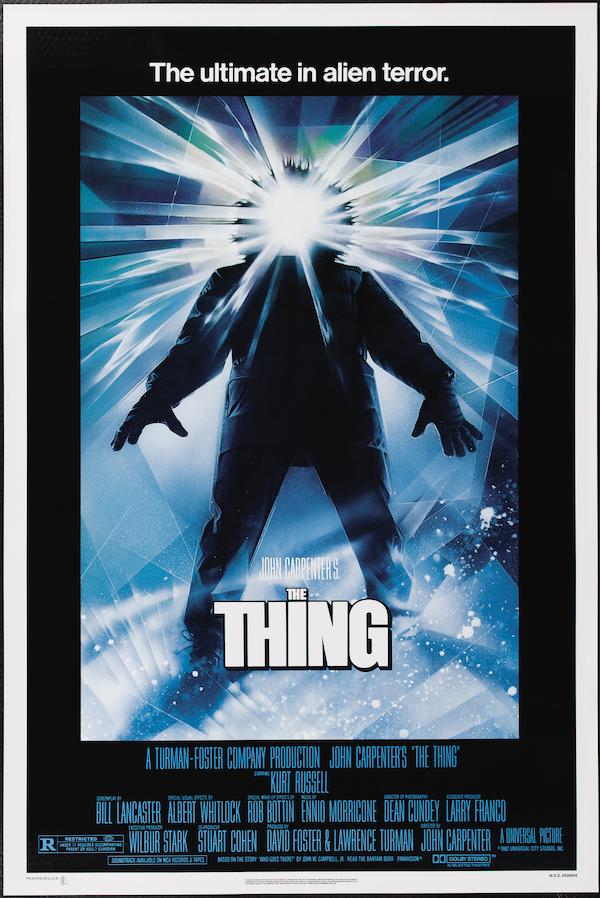
Man is the warmest place to hide.
Considered by many to be John Carpenter’s finest film, The Thing is a legendary horror movie that utilised state-of-the-art practical effects and a tense atmosphere to extract every bit of horror from the stellar script by Bill Lancaster. Lancaster, in turn, adapted the 1938 novella “Who Goes There?” by John W. Campbell, Jr., writing under the pen name ‘Don A. Stuart’
The plot revolves around a group of researchers stationed in Antarctica encountering an alien organism that is the perfect predator. It can infect any living tissue and masquerade as any living thing, and when the time is right, it alters its biology to turn itself into a weapon.
Carpenter considers the film to be part of his Apocalypse Trilogy, along with Prince of Darkness (1987) and In the Mouth of Madness (1994) the three seemingly unrelated films all joined together by the thread that they each deal with a potentially apocalyptic scenario; in this case, should The Thing ever reach civilization, it would be a matter of three years before it consumes humanity and takes over earth. A fact that the movie points out when Blair runs a computer simulation.
The movie has seen a bit of a renaissance in recent years, the themes of Contagion, isolation, asymptomatic infection and paranoia hitting a little differently in our post-COVID world.
Part cosmic horror, part tight isolation and paranoia-filled nightmare, The Thing set squishy, gooey the standard for all body horror movies to come after it.
Videodrome (1983)
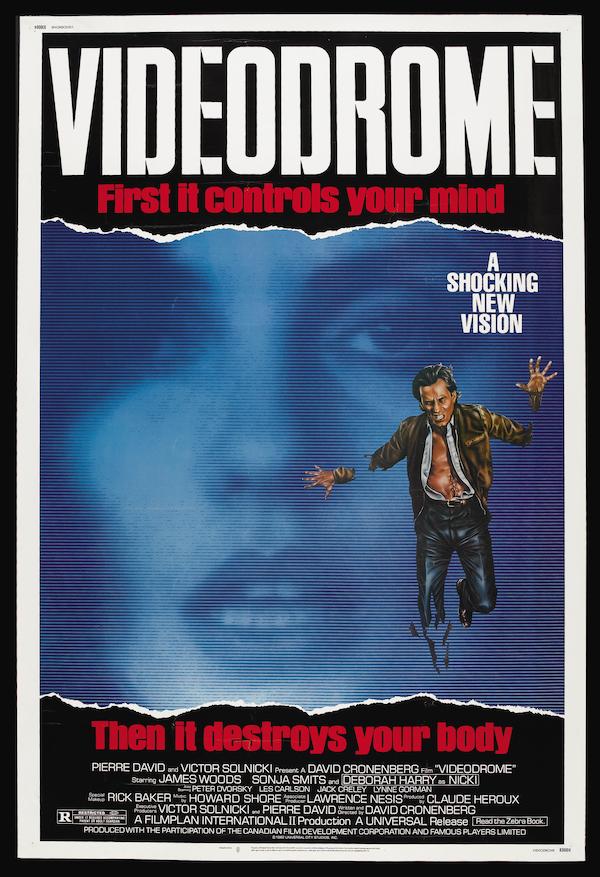
First, it controls your mind, then it destroys your body.
An early work, but worthy of a place on this list. We follow Max Renn (James Woods), a seedy cable executive seeking content to give his channel, Civic TV, an edge. He believes that a strange signal a friend found might be just what he needs. He stumbled upon a pirate broadcast of Videodrome, a channel that features disturbingly real snuff and torture videos.
Max being a mixture of a douche bag and a sleaze ball-a douche ball, if you will-sees all this human misery and wants more. Max is more than an observer in the acts of depravity he finds so titillating, he soon gets in way deeper than he intended to.
Enter Nikki Brand (Debbie Harry), Max’s new girlfriend, a masochistic radio host who’s way too into Videodrome’s sadistic power and control. She is such a fan of the show that she wants to find out where it’s broadcast from and star in one of their films.
Videodrome, it transpires, is more than just a show; it’s a weaponised broadcast designed and engineered to cause tumours to grow in the brains of its viewers that warp perception and control minds.
Some of the disgusting treats that await you in the film include a man growing a fleshy organic VHS slot in his chest, the same poor sod getting a gun fused to his hand, and a complete smorgasbord of hallucinations where flesh and tech meld together.
The Fly (1986)
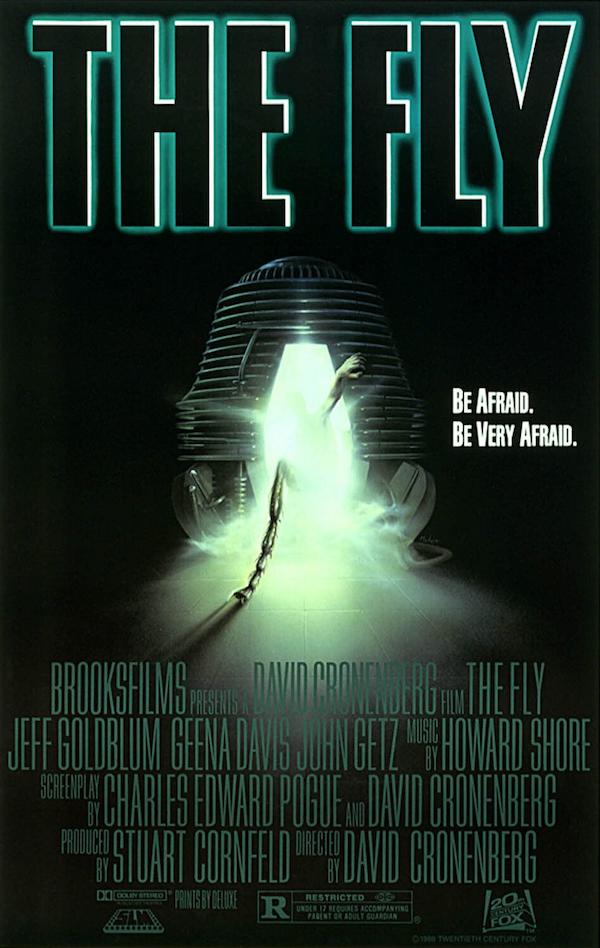
Be afraid. Be very afraid.
A remake of the 1958 original of the same name, this David Cronenberg-directed horror classic chronicles one man’s journey from quirky, slightly batty, and oddly endearing scientist into a horrific and twisted man-housefly hybrid.
Seth Brundle, played by Jeff Goldblum, is a scientist who wants to revolutionise the world with his invention, teleportation. But there’s one minor design flaw… if something gets in your pod with you, it will fuse to you on a genetic level, resulting in an unholy abomination. In the erstwhile Dr. Brundle’s case, it was a simple house fly.
The film is part tragic romance and part classic monster movie. It documents Seth’s change into ‘Brundlefly’ in stomach-churning detail. Christopher James Walas won an Academy Award for his special effects work on the film, cementing its position as one of Cronenberg’s finest works.
Cronenberg has said that Brundle’s transformation in the film is a metaphor for ageing and the decay that awaits us all. The makeup team gives Jeff Goldblum a cancerous, mouldy appearance that gets worse as his altered genetics take over, culminating in a final form that’s haunted my dreams—and my stomach—ever since.
Society (1989)

In Beverly Hills, what you fear is only the beginning
In his directorial debut, Brian Yuzna delivers a tour de force of a horror film that almost feels like he saw Cronenberg’s Oeuvre and said, ‘Why not sexier?’
Focusing on Bill Whitney, a young man who lives a comfortable life in a Beverly Hills mansion, but something is slightly…off about his family. Playing on themes of mental health issues and impostor syndrome, the film keeps you guessing right until the end if Bill is off his rocker and his parents are just odd, or if there is something far darker going on.
The atmosphere of paranoia builds until the legendary ‘Shunting’ scene in the final act, where Bill learns that the rich members of society are, in fact, shape-changing, sex-crazed members of another species that enjoy nothing more than throwing orgies and feasting on those they consider to be lesser.
It’s a surreal ride and one that makes a little more sense once you know Yuzna has admitted to building the plot around surreal special effects he wanted to try, favouring grotesque dream logic over strict narrative cohesion.
The makeup was provided by ‘Screaming Mad George,’ whose unforgettable work earned the film a Silver Raven award for Best Makeup at the 1990 Brussels International Festival of Fantasy Film.
Slither (2006)

Slug it out.
Before he directed talking raccoons and stoic badass ladies of several primary colours for Marvel, James Gunn gave us this slimy, schlocky love letter to ‘80s creature features—and it is glorious. Slither takes place in the small town of Wheelsy, where something sinister crash-lands from space and starts turning people into goo-filled hosts for a hive-minded alien parasite, as you do.
The infection begins with Grant Grant (just go with it), a local big shot played with scenery-chewing perfection by Michael Rooker. After a close encounter with the alien meteorite, Grant begins to mutate—first emotionally, then very, very physically. What follows is a gloriously grotesque blend of tentacles, bloated body bags, and insectile mind control.
Elizabeth Banks and Nathan Fillion round out the cast, trying their damndest to deal with an outbreak that’s one part Invasion of the Body Snatchers and one part The Blob, with a sprinkle of gross-out humour for good measure.
It’s all over-the-top in the best way, with some of the most delightfully disgusting creature effects this side of the Cronenberg family tree, including one poor girl mutating into a human tick the size of a garden shed who shrieks “I’m so hungry!” before exploding.
Slither doesn’t try to reinvent the wheel, but it does run it over repeatedly with giddy abandon. If you like your body horror served with a side of camp and gallons of viscera, this is the one for you.
Contracted (2013)
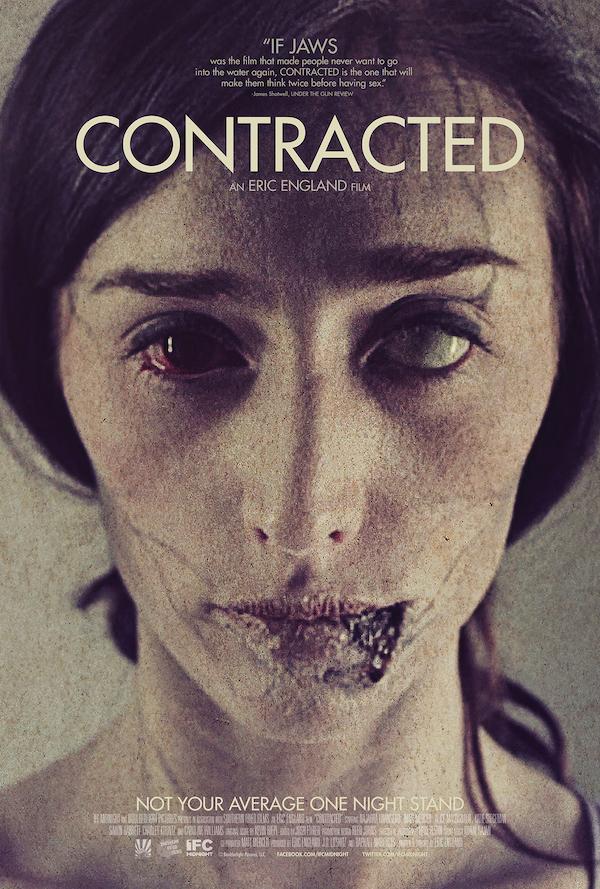
– Trigger warning: this one is GRIM
Don’t touch anyone
The ick factor in this entry begins in the stratosphere and only intensifies from there. The film opens with a real sack of human garbage, BJ, who comes in hot by having the first thing he does on camera be an act of necrophilia, and then goes on to drug and rape our protagonist, Samantha, at a party.
The next morning, she wakes up with a hangover that fights back and starts exhibiting all kinds of symptoms, which begin as a nasty rash and bleeding from downstairs, and soon escalates to full-on body horror.
Contracted is, at its heart, a zombie movie, but one that focuses on an individual victim succumbing to the rot. Because the process of Samantha’s mental and physical deterioration is so slow, taking place over three agonising days, we feel every inch of her transformation. By the film’s end, when she has been completely taken over, it’s heartbreaking.
Dealing with classic body horror themes like loss of bodily autonomy, with poor Samantha literally rotting away before our eyes. Contracted feels like a rather blunt metaphor for STDs, sexual violence and how society treats victims, especially females, as tainted or hysterical.
Contracted was followed in 2015 by a sequel, Contracted: Phase II, which continues the story from where it was left off.
Bite (2015)
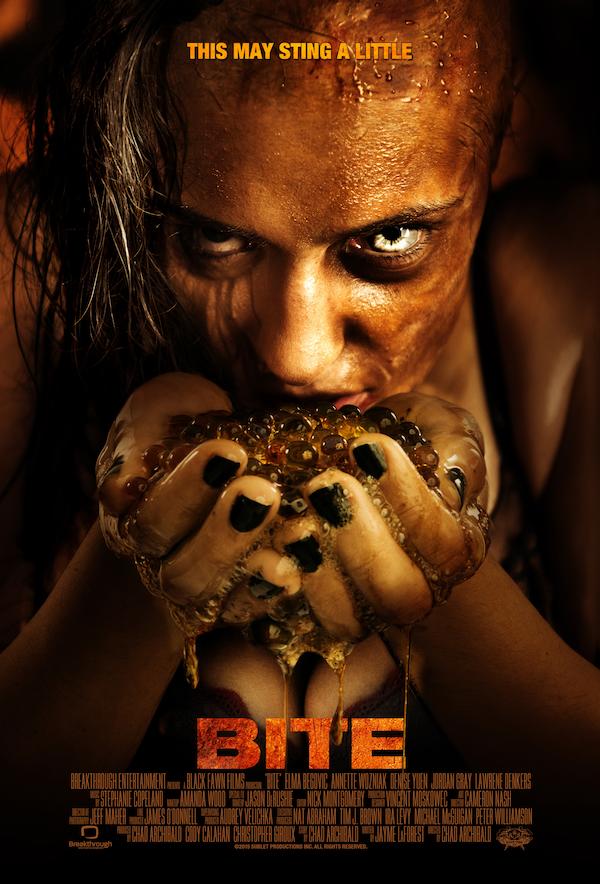
This may sting a little.
Short and about as far from sweet as it is possible to get, this Canadian entry clocks in at a lean 88 minutes long and focuses on Casey (wonderfully played by Elma Beyovic), who is on holiday in Costa Rica to celebrate her bachelorette party. She is getting cold feet about her upcoming nuptials. While out enjoying herself, she gets bitten by a mysterious bug and, once home, starts a horrifying transformation into an insectoid monstrosity. So stomach-churning are the practical effects that during the world premiere at the Fantasia Film Festival, two people fainted and another lost their lunch.
Although the first seven or so minutes are presented in a video-log/found footage style, which could have been quite an interesting approach, the rest of the film, once Casey is home and gets to the serious business of mutating, is told more traditionally.
Casey’s deterioration starts with hypersensitivity to sound, stomach trouble, skin abrasions, and the uncanny ability to sleep underwater. But soon as her symptoms worsen and her life, and impending wedding, start to fall apart at the seams, so does her very biology.
There is one memorable scene where Casey, well and truly in the throes of her horrific and painful mutation, kills her frightful mother-in-law-to-be by vomiting acidic bile onto her face.
Does for insects what ‘Jaws’ (1975) did for sharks, definitely makes you want to stock up on Raid bug spray.
Possessor (2020)
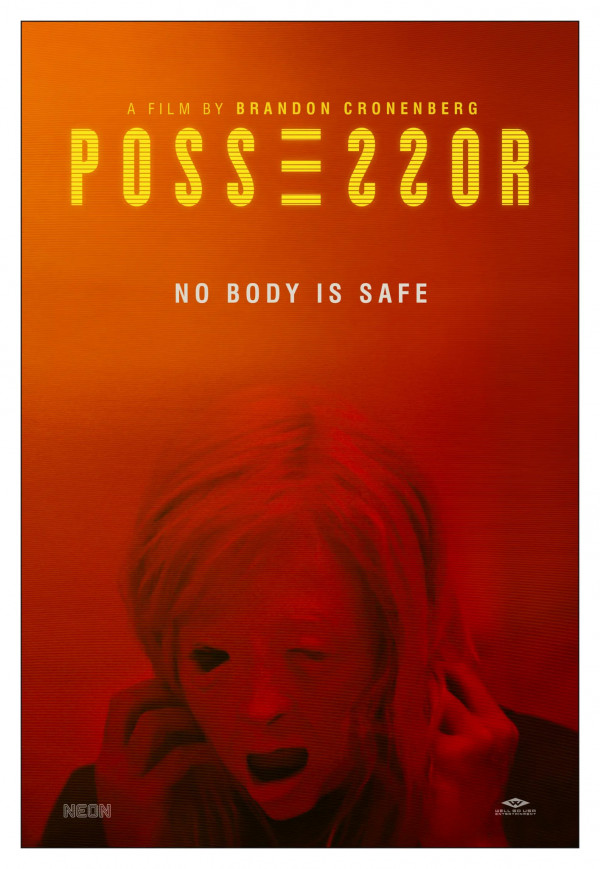
No Body is Safe
Written and directed by Brandon Cronenberg (son of David, but very much his own twisted mind), Possessor is a chilling, cerebral slice of science fiction that asks: what if the most dangerous assassin in the world was a little too good at pretending to be other people?
Tasya Vos (Andrea Riseborough) is a corporate hitwoman who hijacks people’s bodies using brain-implant technology. She steps into their skin, carries out a hit, and forces them to commit suicide before bailing out—neatly tying up any loose ends. But the more time she spends wearing other people, the more her own identity begins to splinter.
Her latest assignment—inhabiting Colin (Christopher Abbott), the soon-to-be-son-in-law of a powerful tech mogul—is supposed to be routine. But things start to slip. Vos has trouble maintaining control. Colin’s personality begins to push back. What follows is a jarring, surreal breakdown of both characters’ identities, where memory, will, and flesh all blur together.
Possessor leans hard into the psychological aspects of body horror, but doesn’t skimp on the visual carnage either. There are sequences so brutal and unflinching they make Videodrome look like a spa day. Hallucinatory flashes, identity collapse, and one of the most disturbing uses of a mask I’ve seen in years make this one of the most original and upsetting entries in the genre.
It’s violent. It’s intelligent. It’s Cronenberg Jr. proving that body horror is still evolving—and sometimes, the most terrifying place to be isn’t someone else’s body. It’s your own.
Infinity Pool (2023)

Find out what kind of a creature you really are.
Li Tolqa is an exotic resort destination with a dark and twisted justice system. A system that the film’s protagonist, struggling novelist James Foster (Alexander Skarsgård), becomes all too familiar with after he commits a fatal hit-and-run one night. The island’s laws are very clear: a life for a life. However, there is a loophole: you can pay for a clone of yourself, one with all your memories and personality, to take the punishment for you. It’s completely bonkers but fits within the narrative of the story.
Infinity Pool is, at its heart, the story of how a normal man can become groomed, given the right circumstances, into becoming a monster. We’re led to believe that anywhere outside of the resort is a perilous place for the tourists to venture; however, by the end of the film, you can’t help but wonder, where are the fences there to keep the locals out… or the tourists in?
The film, although lacking the metamorphosis and more ‘gooey’ aspects of other body horror films, instead focuses on the psychological aspects, such as loss of bodily autonomy, as when James undergoes psychedelic-fuelled sequences where his sense of self and physical reality distorts, combined with some ruthless scenes of violence make for a deeply uncomfortable and harrowing watch.
The Substance (2024)
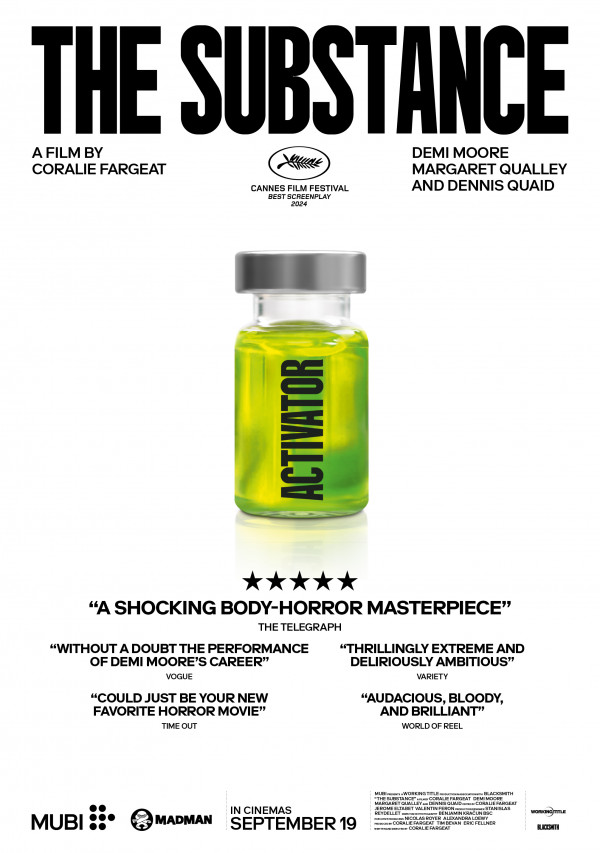
Have you ever dreamt of a better version of yourself?
Fearless and stomach-turning, Coralie Fargeat offers an unflinching satire and a scathing examination of society’s dual beauty standards. Elisabeth Sparkle (Demi Moore) is a fading star who is fired by the repulsive Harvey (Dennis Quaid) due to her age. Desperate to remain in the limelight at any cost, she takes a black-market substance that will create an alternative, younger version of her, which, upon a traumatic scene of being birthed from the spine of Elisabeth, names herself Sue and becomes an overnight sensation.
There is one small problem: the pair must switch consciousness back and forth every seven days or there will be… consequences.
Elisabeth soon finds that she much prefers being the younger, more beautiful Sue and finds herself bending the rules about the whole ‘seven days on, seven days off’ thing, after all, what’s the worst that can happen?
Twenty-one thousand litres of blood later, we get the answer. The film doesn’t hold back from the body horror, and a great deal of the effects were achieved practically with body suits and makeup.
The film doesn’t just have stiletto-sharp commentary on the inequality of gender and beauty standards, nor does it pin everything on the visceral and harrowing special effects, but it has some of the most brilliant writing and most nuanced acting I have seen in a long while

